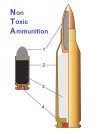A friend passed away, his wife gave me a bunch of his "retired" benchrest barrels. They were carbon fouled, he thought that they were shot out. He did not own a bore scope.
Those barrels are now shooting hummer groups on re-crowned barrels for Stolle Pandas..
Those barrels are now shooting hummer groups on re-crowned barrels for Stolle Pandas..

